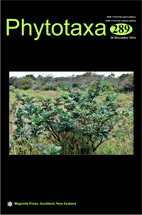Abstract
The Backusella genus comprises mucoralean saprobes that inhabit in mainly soil and form transitorily curved (when young, erect at maturity) sporangiophores arising directly from the substratum, with simultaneous production of both sporangia and sporangiola. During a study of Mucorales in soil from an Atlantic Rainforest in Pernambuco, Brazil, one specimen of Backusella was isolated and characterized based on morphological, physiological and molecular data (ITS1-5.8S-ITS2 and LSU rDNA sequences). The phylogenetic analyses of the isolate revealed that it belongs to the Backusellaceae and is closely related to species of Backusella. The specimen grew better at 25ºC, with no development at 40ºC, and presented conical and cylindrical columellae possessing a central constriction as well as subglobose sporangiospores 7.5–15 × 5.5–10 µm. Based on the evidences of the analyzed datasets, a new species of Backusella is proposed and a taxonomic key for the species of this genus is provided.

